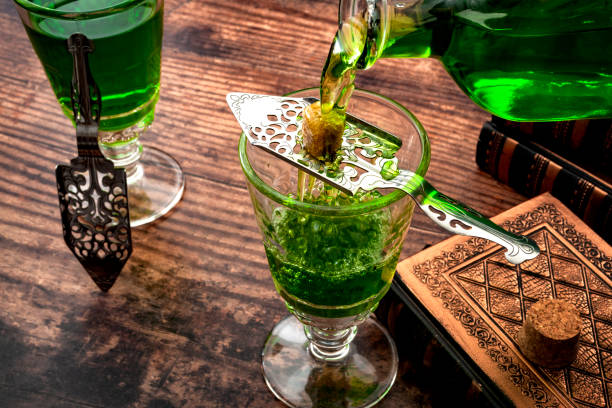There are many versions of the wormwood spirit to suit every taste and cocktail.
Absinthe has been misunderstood for a long time. This is due to its main ingredient, wormwood.
Another reason why absinthe is still a mystery is its ill-defined parameters. There are different standards and definitions for absinthe from one country to the next. Absinthe can be made anywhere, except a restriction on certain ingredients.
One of these ingredients is wormwood. It has been used historically for medicinal purposes. A Greek medical figure, Hippocrates, used the plant’s natural alleviating properties to treat everything, from cramps and rheumatism to menstrual cramps. The birthplace of this once controversial high-octane spirit is Switzerland. Still, it was in Belle Epoch Paris during the late nineteenth century and early twentieth centuries that it became a pariah.
Drinkers of the Green Fairy became more like the green-hued Hulk because they overindulged. After absinthe consumption, there was a lot of bad behavior, and sometimes even violence, which led to the spirit being outlawed across Europe and the United States. Thujone, an ingredient found in wormwood, was blamed for the outcry. This terpene is relatively safe in small amounts but can cause serious health problems in large quantities.
Modern researchers have discovered no historical or modern absinthe with enough thujone for a person to do things like severing an ear. This could be done by drinking too much alcohol. Absinthe was legalized in the E.U. Absinthe was legalized in the E.U. in 1988 with limits on the amount of thujone. The same law was applied in the United States in 2007. (Absinthe-labeled products in the United States must be thujone free, meaning they contain only trace amounts.
The slow but exciting re-legalization of herbaceous drinks has led to a slow but significant revival in their popularity, both here and abroad. A glass with about an ounce of it is filled with water and topped with a flat, flat, absinthe spoon. Slowly, cold water is added to the sugar to dissolve it into the spirit. This invigorates the botanicals, dilutes the spirit (often high-ABV), and creates the louching effect. Many cocktails, both classic and modern, also call for the spirit.
These eight bottles are mainly American and provide a great way to start the spirit.
Absentee Absinthe Refined 111
This Provence-distilled brand relaunched its packaging at the end of 2020. The 55% ABV bottle was placed in a box with Vincent van Gogh’s image and a small absinthe spoon. It was cleaving to the stories that absinthe was associated with outlandish behavior. The spirit’s green color is a bit too bright for me. It has a neon-ish green hue that, when touched, turns to a pale milky-green. This can be used to argue that the bottle is not absinthe. It still has pleasant aromas like fennel candy and coriander.
Absinthia Absinthe Superieure Blanche
This tall, slim bottle looks more like absinthe than you would expect. The certified organic product is also unique in other ways. Marian Farms, Fresno, California, uses biodynamically grown grapes to distill the clear spirit. This 55% ABV bottle contains anise, which is subtle, and it’s infused with other minty, citrusy botanicals along with a touch of sage. It is soft, fresh, and vibrant.
Jade 1901 Absinthe Superiore
It’s impossible to talk about absinthe in America if you don’t mention T.A. Breaux’s Lucid Absinthe Superieure, which was legalized in 2007, was the first to be made available in America. Breaux is an absinthe archeologist, evangelist and hunter for old, well-known recipes to recreate them. Jade 1901, like its name, is a Jade 1901 bottling that was distilled in Saumur (France) at the Distillerie Combier. Jade 1901 is the most sophisticated and complex of the bunch. It is true chartreuse in color and has a strong aroma of leather, musk and rye bread. It is flavored with sweet spices and toasted fennel seed on the palate. Louching reduces the 68% ABV, but it also brings sweetness and a satisfying anise finish.
Leopold Bros. Absinthe Verte
This absinthe is made with Chilean pisco as the spirit base. This bottle contains the traditional botanicals of grand wormwood and anise seed. The spirit base is 65% ABV, and the spring-like color comes from steeping the spirit with lemon balm and hyssop. It becomes transparent when boiled, and the fragrant fennel takes center stage. It is soft and rich on the palate with a pleasantly sweet, grassy finish.
Tattersall Absinthe Blanche
This Minneapolis entry in the category is as clear as water, but add some, and it turns into a beautiful, translucent, pale opal. If you are new to absinthe, this bottle is worth a try. It is fresh and floral like fresh fennel. There are bright notes of lime peel and marjoram. The organic corn base spirit makes it even more delicious. It picks up wildflower aromas and pine forest when diluted with water.

